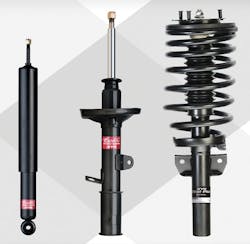Electronic stability control (ESC) is nothing new. Introduced as optional equipment on luxury cars in the mid-1990s, it’s been standard on light-duty truck and passenger vehicles since 2012. What may be new to tire dealers is a value proposition built around helping motorists understand that crash avoidance systems like ESC depend on ride control components to function effectively.
Vehicle safety systems such as antilock brakes and ESC depend on input from the wheels to work properly, according to Eric Banas, product marketing manager for ZF Services LLC, manufacturer of Sachs Shocks and Struts. “As shocks and struts wear, the damping characteristics are reduced, increasing the chances of excessive wheel hop over bumps or hydroplaning in wet conditions, which can lead to extended stopping distances. Replacing worn shocks and struts will ensure the vehicle’s safety systems continue to work as intended.”
Technicians need to be aware of the relationships of the supporting mechanical systems that allow the crash avoidance technology to function, according to Mac McGovern, director of marketing and training, KYB Americas Corp. For example, tires slow and turn a vehicle, not ESC. As suspension, springs, shocks and struts wear, their ability to control the tires lessens. “ESC and other crash avoidance systems will work properly, but may have to work too hard or too often or may not be effective if there are worn or miscalculated parts in the steering, suspension, brakes or tires.”
ESC depends on the tires’ ability to grip the road. “All of these crash avoidance systems’ effectiveness is largely attributed to ride control components,” says McGovern. A crash-avoidance system’s instructions to change the vehicle’s behavior, such as braking individual wheels, occur whether or not the vehicle is capable of executing them. “If the technology is expecting the vehicle behavior’s to stay within vehicle design so it can contribute to consumer safety, it only makes sense that the service provider understand that technology and make recommendations around this safety system so the customer has a better sense of the value proposition.”
As consumers bring ESC-equipped vehicles to shops for servicing, what do technicians need to do to ensure the crash-avoidance technology functions properly? “A shop can’t assure that ESC will operate properly, they can only look for electronic trouble codes, look for wear or failure of any ride control component and road test the vehicle. The shop’s role is to keep the motorist informed about conditions that could prevent ESC from being as effective as possible when a sudden need occurs,” says McGovern.
[PAGEBREAK]
ESC is a technology that shops certainly should be aware of but not afraid of, according to Bill Dennie, director, ride control channel management for Tenneco Inc., the manufacturer of Monroe shock absorbers and struts. “If you are relying on a quality brand of shocks and struts, you can be confident that there will be no compatibility issues whatsoever with a vehicle’s ESC system, just as you should not worry about which brand of brake pads you are installing on a vehicle equipped with antilock brakes.”
Properly functioning shocks and struts not only smooth out the bumps in the road, they help the vehicle’s safety systems do their job when needed, says Banas. “Sachs suggests replacing worn dampers with quality aftermarket OE replacement shocks and struts that are tuned to the specific application, which will help to restore vehicle safety to its original standards.”
McGovern suggests helping the motorist understand that electronic safety systems depend on ride control components that wear and that replacement parts should always meet or exceed OEM performance capabilities. “Crash avoidance can’t avoid and stability control can’t control if the tires can’t grip the road or the body control isn’t stable. KYB’s focus is on products that restore designed performance because it’s critical to the vehicle’s safety systems.”
Because ESC and crash avoidance systems are electronically looking at the steering, suspension, brake and tire systems at once, a shop can put together a sales plan that complements vehicle technology, according to McGovern.
“The relationship between mechanical and electronic is critical to overall vehicle performance so that’s the beginning of the value proposition. The customer understands tires and the customer understands safety systems, so let’s build a selling culture around that.”
McGovern says earning a sale is a process and suggests looking at sales of ride control components from the customer’s perspective. “They don’t like surprises and they can’t make high-dollar decisions on the spot. So earning shock and strut sales is about planting the appropriate seeds. Do that by reporting on current vehicle conditions. Do that by setting goals or expectations of the vehicle which usually needs to be designed vehicle performance.
“You help them understand what it takes to keep their vehicle within those performance capabilities. Then you offer shocks and struts and the opportunity to think about it.”
Closure on a sale usually happens on the first follow-up visit, according to McGovern. “So the advice to the store is not to create a selling plan; it is to create a planting seeds plan because you have to concentrate on the first follow-up visit.” ■




